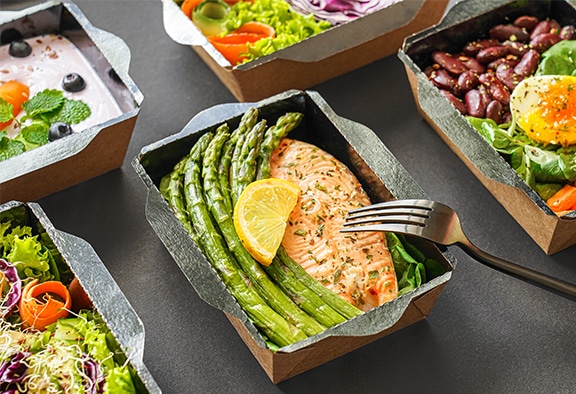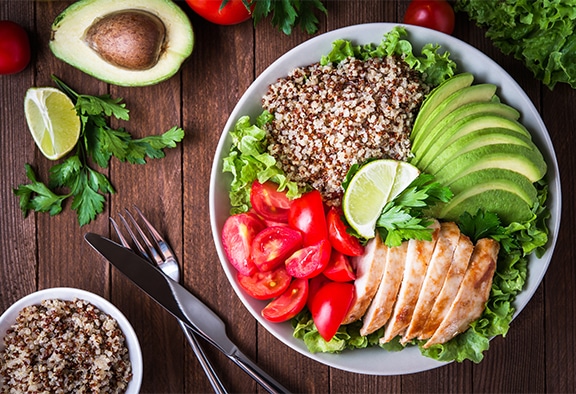
Creating a balanced diet is an essential element of your diabetes management strategy. Before you start working on a meal plan for diabetes, read up on the food groups and portions you should include in your diabetes diet.
Meal Planning for Diabetes
If you have type 1 or type 2 diabetes, controlling your blood sugar is one of your highest priorities. You can take several actions to pursue this goal, such as getting more physical activity and tracking your glucose levels. Another highly effective step towards keeping your blood sugar within range is improving your diet.
Meal planning is crucial for people living with any form of diabetes. While you shouldn’t make any significant dietary changes without the approval of your healthcare team, it’s not a bad idea to read up on the fundamentals of a healthy diabetes diet ahead of time. Here, you’ll find valuable information from ADS on creating a nutritious meal plan for diabetes.
Include These Foods in Your Diabetes Diet
Unlike many “fad diets,” a well-thought-out meal plan for diabetes doesn’t exclude any food group—even carbohydrates. Instead, you should focus on including balanced portions of these food groups in your diabetes diet:
Fruits and Vegetables for Diabetes Management
Since vegetables are packed with fiber and are low in salt and fat, they’re a big part of any healthy diet. With that in mind, you should add lots of veggies to your diabetes meal plan. That could include greens like kale and spinach, other cooked or raw fresh vegetables, and even steamed frozen veggies. (Of course, you’ll want to add starchy vegetables like corn and potatoes to your daily carb count.)
Fruits are typically higher in carbohydrates than vegetables are. Still, they can be a nutritious dietary choice thanks to their high levels of fiber, vitamins, and minerals. Add this food group to your meal plan in the form of fresh fruit, low-sugar or sugar-free jams and preserves, plain frozen fruit, and applesauce with no added sugar. It’s also worth noting that fiber-rich fruits like berries can have a reduced impact on your blood sugar.
Protein Sources for Diabetics
Choosing protein sources is one of the easier parts of putting together a diabetes meal plan. People with diabetes can eat meat, poultry, tofu, dairy, and fish without trouble. Prioritizing plant-based protein sources is wise—beans and other plant proteins have additional fiber and nutrients. At the same time, try to avoid high fat, or processed proteins like pork chops, bacon, sausage, and ribs.
Carbohydrates for Diabetics
On the other hand, it can be tricky for people with diabetes to find carbohydrates that don’t cause blood sugar problems. The key is eating moderate portions of whole-grain carbohydrates (such as brown rice and oatmeal) while avoiding simple carbs when possible.
In addition to eating the right carbohydrates, you should keep track of the carbs you consume. This process, known as “carb counting,” can help you limit your per-meal and daily carbohydrate intake. Controlling your blood glucose levels will be much easier when you take carb counting seriously.
What Beverages Are Good for Diabetics?
It’s surprisingly easy to forget drinks in your meal-planning efforts. Even so, that doesn’t mean you can afford to ignore them. Healthy beverage options for people with diabetes include black coffee, sugar-free flavored sparkling water, unsweetened tea, and water.
Meanwhile, steer clear of sugary sodas, juices or other beverages that are packed with carbs—they can cause your blood sugar to spike rapidly. And while some people with diabetes can safely enjoy alcoholic beverages, talk to your healthcare team before adding these drinks to your diabetes meal plan.
Use the Plate Method for Portion Control in the Diabetes Diet
By following the advice listed above, you’ll be ready to fill your plate with delicious, nutritious foods. Still, even the best meal plan for diabetes needs to account for portion control. For that, you’ll want to use a technique called the “plate method.”

The plate method is based on a nine-inch dinner plate. To start, take a plate of this size and mentally divide it into quarters. When it’s time to put food on your plate, you should:
- Fill two-quarters (one-half) with nonstarchy vegetables. That could include salad, broccoli, carrots, green beans, or any other veggie that falls into this category.
- Fill one-quarter with a lean protein. Turkey, chicken, tofu, beans, and eggs are all excellent choices.
- Fill one-quarter with carbohydrates. These should be foods that are higher in carbs but are still nutritious, such as whole-grain rice, starchy vegetables, or fresh fruit.
- Accompany your plate with a glass of water or another low-carb beverage.
Portion Size vs. Serving Size for Diabetes Management
Do you use the terms “portion” and “serving” interchangeably? Many people do, but these words have two different meanings. A serving is a predetermined amount of food—say, a slice of bread. In contrast, a portion is whatever amount of food you eat in one sitting.
If you’re following a diabetes diet plan, you need to remember the difference between these two phrases. That’s because portion sizes at restaurants have been growing as of late. These days, an entrée can contain three or four servings while still technically being a single portion of food.
The simplest way to control portions while eating out is to take half of your meal in a to-go box. At home, you can measure snacks ahead of time, keep serving bowls out of your reach during meals, and estimate portion sizes with your hand:
- Three ounces of meat, poultry, or fish = palm of hand (not including fingers)
- One ounce of cheese or meat = thumb (base to tip)
- One cup/one medium fruit = fist
- One or two ounces of a snack = cupped hand
- One tablespoon = thumb tip (first joint to tip)
- One teaspoon = fingertip (first joint to tip)
Get More Diabetes Support from ADS
Following these tips should help you start thinking about your ideal meal plan for diabetes. Needless to say, building a diabetes diet is still a complicated process. Be sure to consult your healthcare team for additional advice and insight as you work to create a diet that fits your needs.
Are you looking for more dietary information online? If so, you’re in the right place—ADS has dozens of blog articles on this topic. We can also simplify your diabetes management efforts by serving as a reliable provider of CGMs, glucose meters, and other vital diabetes supplies!
